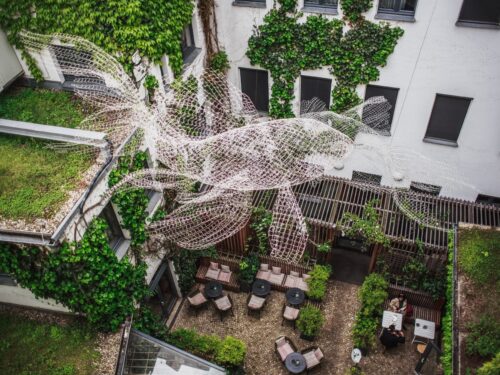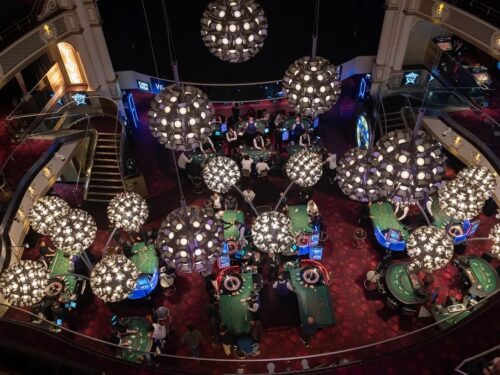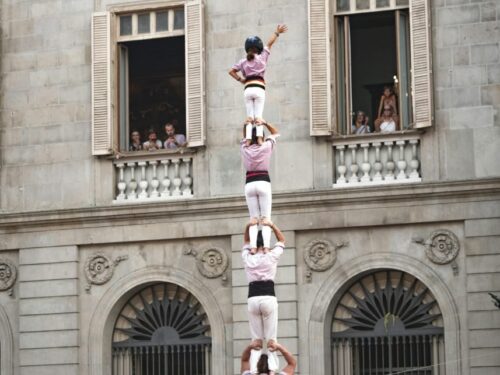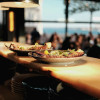The nightlife in Berlin is renowned for its diverse and vibrant clubbing culture, attracting music enthusiasts from around the globe. This article takes you on a thrilling journey through five legendary nightclubs, which I call Berlin’s Big Five.
These Berlin nightclubs were built by marginalized communities and have become synonymous with Berlin’s after-dark scene.
From the rebellious spirit of SO36 to the provocative allure of Kit Kat Club, and the techno meccas of Tresor and Berghain, discover the essence of Berlin’s nightlife through these iconic venues.
Related read: The Best Bars in Berlin
Berlin Nightlife Tour
Want to explore the vibrant club scene of Berlin? Join Jeff, a local, and discover with him the fascinating history behind each club, as well as all the wild parties that go down. This is no ordinary tour – it’s an immersive experience in augmented reality that you won’t find anywhere else.
Come along for a truly unique adventure into Berlin’s legendary nightlife!
Explore Berlin’s nightlife and book directly at Jeff’s website!
Here is an overview of Berlin’s Five Iconic Nightclubs:
SO36: Embracing Alternative Excellence, A Haven for Legends like David Bowie and Iggy Pop, and Unforgettable Opening Nights
Nestled in Kreuzberg, SO36 stands as a cultural landmark embodying Berlin’s alternative and punk scene. Since its inception in the late 1970s, this legendary venue has not only hosted electrifying live performances but also became a space for memorable and boundary-pushing events. One such event that left an indelible mark on SO36’s history was its opening night, attended by renowned artists like Iggy Pop.
Known for his raw energy and influential contributions to punk and rock music, Iggy Pop was drawn to the vibrant music scene in Berlin during the late 1970s. It was no surprise that he made an appearance at the opening night of SO36, an event that perfectly encapsulated the spirit of rebellion and artistic expression that he embodied.

Iggy Pop and Crying Punks
On that eventful night, which happened to be the 16th anniversary of the building of the Berlin Wall, SO36 and the local punk community sought to create a powerful statement that reflected Berlin’s divided history. As a symbolic representation of the city’s infamous Berlin Wall, a cake was crafted to resemble the imposing barrier. The cake-wall stood tall, a confectionary representation of the physical and ideological divisions that had plagued Berlin for years.
The atmosphere inside SO36 was charged with anticipation as the punk community gathered around the cake-wall. With Iggy Pop among them, the punks, known for their confrontational nature, channeled their energy into a symbolic act of defiance. With teeth and fists, they unleashed their fury upon the cake-wall, demolishing it with fervor, embodying their rejection of the wall that separated them.
However, amidst the chaos of destruction, an unexpected wave of emotions swept through the crowd. Tears welled up in the eyes of the punks. The destruction of the cake-wall became a poignant moment of reflection, revealing the pain, longing, and frustration that lay beneath their outward defiance. Their tears, a testament to the emotional toll that Berlin’s division had taken on its inhabitants, added an element of melancholy to the fervent rebellion.
How SO36 Inspired David Bowie
It was within the walls of SO36 that David Bowie, a visionary and an influential figure in the music industry, also found solace and inspiration during his time in Berlin. Bowie, known for his ability to reinvent himself and push creative boundaries, was drawn to the city’s vibrant music scene and the alternative spirit that permeated venues like SO36.
His presence at SO36 added an extra layer of significance to the club, solidifying its reputation as a hub of artistic expression and rebellion. Bowie’s interactions with the Berlin music scene, including his visits to SO36, played a role in shaping his iconic “Berlin Trilogy” of albums, which became a testament to his creative evolution and his immersion in the city’s vibrant culture.
Today, SO36 continues to embody the spirit of alternative music, countercultural expression, and community. It stands as a testament to the power of music, art, and unity to challenge societal norms, provoke emotions, and inspire change. With its storied history and the presence of influential artists like Iggy Pop and David Bowie, SO36 remains a symbol of Berlin’s cultural resilience and its enduring commitment to creativity and rebellion.
Pro Tipp: Kiezbingo
In addition to its live performances and vibrant atmosphere, SO36 is also known for hosting unique events, such as the popular Kiezbingo nights, where locals and visitors alike gather for a lively game of bingo infused with the spirit of the Kreuzberg neighborhood and the roasting of the bingo winners by two local drag queen hosts, creating an unforgettable experience filled with laughter, fun, and a sense of community.
SchwuZ: A Queer Haven of Expression, Championing LGBTQIA+ Rights, and Fostering Inclusivity
Located in Neukölln, SchwuZ has long been an essential space for Berlin’s LGBTQIA+ community and beyond. Beyond its vibrant atmosphere and diverse parties, SchwuZ has played a pivotal role in shaping LGBTQIA+ history in Berlin and Germany, standing as a symbol of resilience, activism, and inclusivity.
During the 1970s, SchwuZ was founded by the Homosexuelle Aktion Westberlin (Homosexual Action West Berlin), an influential gay rights organization. SchwuZ served as a platform for the group’s events, providing a safer space for the community to gather, organize, and advocate for equal rights and societal acceptance. Through their collaborative efforts, SchwuZ and the Homosexuelle Aktion Westberlin contributed to significant advancements in LGBTQIA+ rights, leaving an indelible mark on Berlin’s queer history.

The Devastating Impact of the AIDS Crisis
In the 1980s and 1990s, Berlin, like many cities around the world, faced the devastating impact of the AIDS crisis. SchwuZ responded to the crisis by becoming a center for education, support, and solidarity. The club hosted fundraisers, awareness campaigns, and safer spaces for those affected by HIV/AIDS, fostering a sense of community resilience in the face of a dire health crisis. SchwuZ’s proactive response during those challenging times demonstrated its unwavering commitment to the LGBTQIA+ community and the broader fight for health equality and compassion.
Diversity and Inclusion
In 2015, as large numbers of refugees came to Europe, SchwuZ once again opened its doors. LCavaliero Mann, the artistic director of SchwuZ, initiated the Tasty Party, highlighting music and queer artists from South-West Asia and North Africa. This act of inclusivity highlighted SchwuZ’s commitment to social justice and its understanding of the intersectionality of struggles faced by marginalized communities. It demonstrated that SchwuZ’s mission extended beyond being a nightclub; it was a space that embraced the values of acceptance, empathy, and solidarity.
Today, SchwuZ continues to thrive as an inclusive haven for the LGBTQIA+ community, hosting an array of parties, performances, and events that celebrate diversity and promote equality. It stands as a testament to the power of nightlife to foster understanding, challenge norms, and create spaces of belonging.
SchwuZ’s rich history of activism and its ongoing commitment to inclusivity ensure that it remains a vital force in Berlin’s LGBTQIA+ culture, continuing to provide a vibrant and safer space for self-expression, celebration, and community building.
Pro Tipp: Schlagernacktparty
In addition to its role in LGBTQIA+ rights and inclusivity, SchwuZ is also known for its iconic Schlagernacktparty, an exuberant celebration that combines two distinct elements: Schlager music and nudity.
Schlager music, a genre of German pop mixed with folk, and characterized by catchy melodies and sentimental lyrics, holds a special place in German culture. The Schlagernacktparty at SchwuZ offers a unique twist to this popular genre, inviting partygoers to shed their inhibitions and clothes while dancing to the infectious beats of beloved Schlager hits.
The Schlagernacktparty embraces the spirit of body positivity, freedom, and self-expression. It creates a welcoming environment where attendees can feel liberated and comfortable in their own skin. The event challenges societal norms and encourages participants to celebrate their bodies, fostering a sense of joy, empowerment, and acceptance.
Address: Rollbergstraße 26, 12053 Berlin
Tresor: The Sonic Citadel of Techno, Pioneering Club Culture and Cooperation with African-Americans
Tucked away in the heart of Berlin, Tresor stands as a testament to the city’s vibrant club culture and its ability to repurpose abandoned spaces into havens of electronic music.
Born in the wake of the fall of the Berlin Wall, Tresor emerged as a trailblazer, transforming a former warehouse vault into a legendary techno institution that would shape the course of electronic music history.
The club’s location today, in a vacant power plant after being forced to shut down the first location in the early 2000s, exemplified the spirit of reinvention and revitalization that swept through Berlin after the reunification. Tresor embraced the raw and industrial atmosphere of its surroundings, creating an immersive experience where the relentless beats of techno reverberated through the cavernous halls, drawing in crowds of music lovers seeking sonic liberation.

Tresor’s influence on Berlin’s techno scene extended far beyond its physical space. In the early 1990s, the club played a crucial role in the transatlantic exchange of electronic music, particularly with Detroit’s Black community. (Like many music genres, techno was born in Black communities.)
Tresor invited techno DJs from Detroit, including pioneers like Juan Atkins, Derrick May, and Jeff Mills, to perform in Berlin. This collaboration fostered a cultural exchange, blending the futuristic sounds of Detroit techno with the raw energy and creativity of Berlin’s underground scene.
This fusion of musical styles and influences created a seismic shift, firmly establishing Berlin as a new epicenter of techno in the 1990s. The unique combination of Berlin’s post-Wall energy and the soulful rhythms from Detroit’s Black DJs gave birth to a distinctive Berlin sound that resonated with audiences around the world.
Tresor became a pilgrimage site for techno enthusiasts, a place where they could experience the cutting-edge sounds of the genre and witness its evolution firsthand.
East and West: All the Same Under the Dictates of the Sound
Beyond its impact on the music landscape, Tresor represented a symbol of unity and freedom in a city that had undergone significant transformation. The club became a meeting point for people from diverse backgrounds, breaking down barriers and bridging divides through the shared love of music. Tresor’s inclusive ethos and commitment to underground electronic music culture created an environment that celebrated individuality, inclusivity, and the power of collective experience.
Today, Tresor continues to thrive as a legendary institution, hosting world-class DJs, live performances, and immersive events. Its influence as a pioneer in repurposing abandoned spaces and fostering transatlantic musical exchange remains unparalleled, cementing its status as a beacon of Berlin’s electronic music scene.
Tresor’s legacy serves as a testament to the enduring power of music to bring people together, transcend borders, and shape cultural movements.
Pro Tipp: Main Dancefloor
At the heart of Tresor’s sonic landscape lies its main floor, a pulsating realm that stays true to the roots of Berlin techno. This space within the club serves as a sanctuary for techno purists and enthusiasts, where the raw and uncompromising sound that defined the early days of the genre in Berlin continues to thrive.
The main floor at Tresor pays homage to the gritty and industrial sound that emerged from the city’s underground scene. With its pounding basslines, hypnotic rhythms, and relentless energy, the main floor transports dancers to a realm where time and space dissolve, allowing them to surrender to the immersive power of the music.

Kit Kat Club: Embracing Berlin’s Cultural Legacy, Celebrating Sexual Liberation, and Fostering Discussions on Consent
Kit Kat Club, a legendary institution in Berlin’s nightlife, draws its inspiration from Christopher Isherwood’s “Berlin Stories”, where a club called Kit Kat played a prominent role.
This connection to literary history adds an extra layer of intrigue to the club’s vibrant atmosphere and uninhibited spirit. Moreover, the origins of Kit Kat Club can be traced back to the Eldorado club, which thrived during the 1920s in Berlin until the rise of Nazi power.
Like its predecessors, Kit Kat Club embodies a spirit of sexual liberty, gender and sexual diversity, and exploration of kinks and fetishes. The club embraces Berlin’s reputation as a haven for self-expression, attracting a diverse crowd of individuals who are eager to explore and celebrate their unique desires and identities.

Sexual Liberation
At Kit Kat Club, the atmosphere is charged with a palpable sense of liberation. The club is even home to a swimming pool and a sauna and encourages its patrons to express themselves freely, embracing a wide spectrum of sexual orientations, gender identities, and kinks. It creates an environment where individuals can shed societal expectations and fully embrace their authentic selves without fear of judgment or discrimination.
Beyond its electrifying parties and risqué dress codes, Kit Kat Club is also committed to fostering discussions around sexual consent. The club recognizes the importance of establishing clear boundaries and promoting a culture of consent within the context of sexual exploration. With its motto, “do what you want, but stay in communication”, the club actively encourages open conversations, education, and awareness about consent, ensuring that all patrons feel safe, respected, and empowered to navigate their experiences with mutual respect and understanding.
Sexual and Gender Diversity
Kit Kat Club stands as a symbol of Berlin’s acceptance of diverse sexual expressions and the celebration of personal freedom. It serves as a reminder of the city’s tumultuous past and its ongoing commitment to reclaiming and embracing sexual liberty, even in the face of historical oppression.
By embracing its literary and historical inspirations, Kit Kat Club not only pays homage to the vibrant cultural legacy of Berlin but also creates a space where individuals can explore their desires, challenge societal norms, and celebrate the rich tapestry of human sexuality.
It continues to be a beacon of acceptance, sexual expression, and open-mindedness, ensuring that Berlin’s reputation as a hub of sexual liberation remains intact in the 21st century.
Pro Tipp: Somnambul or Electric Monday
In addition to its regular events, Kit Kat Club offers two notable nights that provide a departure from the club’s strict dress code while maintaining its vibrant and uninhibited atmosphere: Somnambul on Sundays and Electric Monday on Mondays.
Somnambul, held on Sundays, offers a unique experience at Kit Kat Club where the dress code is more relaxed compared to other nights. While still embracing the club’s spirit of sexual liberation and self-expression, attendees have the freedom to dress in more casual or comfortable attire, allowing for a more laid-back and inclusive atmosphere.
This night attracts a diverse crowd, including both regulars and newcomers, who gather to enjoy the eclectic mix of music and the open-minded ambiance that Kit Kat Club is renowned for.
Electric Monday, as the name suggests, takes place on Mondays and is another event that allows attendees to explore the club without adhering to a strict dress code.
It has become a popular night for techno enthusiasts, attracting both local and international DJs who deliver exhilarating sets. Electric Monday offers a more relaxed and accessible environment for music lovers to immerse themselves in the pulsating beats of electronic music while enjoying the unique atmosphere that Kit Kat Club provides.
Address: Köpenicker Straße 76, Brückenstraße 1, 10179 Berlin

Berghain: Unleashing the Power of Techno, Embracing Sexual Freedom, and Defying Expectations
Berghain, the iconic techno mecca of Berlin, has etched its name in the annals of the nightlife in Berlin’s history. Berghain’s roots can be traced back to the Snax Club parties held at Bunker, an abandoned factory turned club, which laid the foundation for what would become a legendary institution.
Ostgut, a gay club that preceded Berghain, played a pivotal role in the development of Berghain. The club was conceived as a haven for self-expression and sexual liberty, initially built by and for the gay community, and now open to everyone, where individuals can freely explore their desires and identities without judgment.

No Photos allowed
One distinctive aspect of Berghain is its strict no-photo policy. (Actually, one-third of Berlin clubs don’t allow photos inside.) This rule fosters an environment where attendees can immerse themselves in the music and atmosphere without the intrusion of social media or external distractions. It creates a sense of freedom and privacy, allowing visitors to fully engage with the experience and each other without the pressure of constant documentation.
Berghain’s notoriety extends beyond its musical reputation. Stories of the club’s exclusivity have become legendary, with even high-profile figures like Elon Musk reportedly being denied entry. This selectiveness is not merely based on celebrity status but is rooted in the club’s desire to maintain an intimate and inclusive environment, valuing the overall vibe and energy of the crowd over individual fame.
Berghain takes pride in its commitment to providing a safer space for marginalized communities. It embraces a philosophy of acceptance, respect, and tolerance, creating an atmosphere where individuals from all walks of life can freely express their identities and desires. The club’s dedication to fostering sexual liberty and self-expression has made it a sanctuary for those seeking an inclusive and nonjudgmental environment.
Respectful Party Tourism
Berghain also teaches us about respectful party tourism. Visitors from around the world come to experience the unique energy and immersive techno soundscape that Berghain offers. However, it is crucial for tourists to approach the club with an understanding of its ethos, respecting the space, its patrons, and the established culture. By embracing the club’s values, tourists can contribute to the preservation of Berghain’s unique atmosphere and ensure a positive and authentic experience for all.
Within the Berghain complex, the gay club Lab.Oratory stands as an experimental space that pushes boundaries and explores the realms of sexual freedom and expression. This infamous sex-positive venue within the club has not only become a haven for exploration but has also inspired artists beyond the electronic music scene. Lady Gaga’s song “Scheiße” was reportedly influenced by her experience at Lab.Oratory, reflecting the club’s impact on artistic expression and creativity.
Berghain’s legacy extends far beyond its music and renowned door policy. It represents a place of liberation, a sanctuary for sexual diversity, and a platform for artistic exploration. As the Berlin nightlife landscape continues to evolve, Berghain remains a beacon of expression, attracting seekers of authentic experiences and forging an indelible mark on the global clubbing scene.
Pro Tipp: Go There Sunday (After-)Noon
The Sunday afternoon experience at Berghain holds a special place in the hearts of typical Berliners, who have mastered the art of embracing the city’s vibrant nightlife. It is a time when locals gather, creating a unique sense of community and shared energy. One notable advantage of arriving at this time is the relatively shorter queue, compared to the peak hours of the night. This can alleviate the frustration that comes with the possibility of being rejected at the club’s notorious door.
Address: Am Wriezener bhf, 10243 Berlin

Berlin Nightlife Tour
Hang out with Jeff, a Berlin local, and explore with him the city’s hottest clubs, while discovering their rich history and legendary parties. This one-of-a-kind augmented reality tour of Berlin’s club scene is unlike anything else out there!
Explore Berlin’s nightlife and book directly at Jeff’s website!
Conclusion
Berlin’s nightlife scene thrives within the unique atmospheres of these five iconic nightclubs.
SO36 captures the essence of Berlin’s alternative and punk heritage, while SchwuZ offers a welcoming space for LGBTQIA+ communities to thrive. Tresor’s dedication to underground electronic music from Detroit’s Black community and Kit Kat Club’s exploration of erotic freedom push boundaries, leaving indelible impressions on visitors. Lastly, Berghain’s techno pilgrimage ensures an unmatched experience for music aficionados.
Together, these Big Five form the beating heart of Berlin’s nightlife, encapsulating the city’s boundless energy, inclusivity, and artistic expression.









